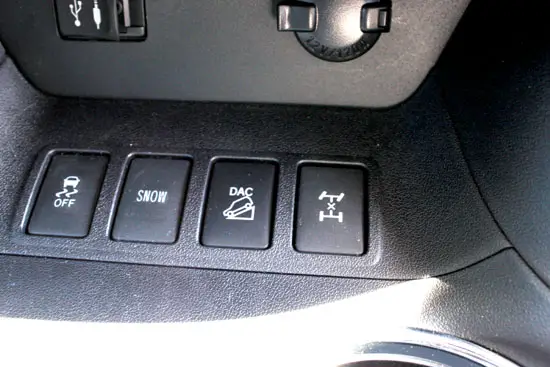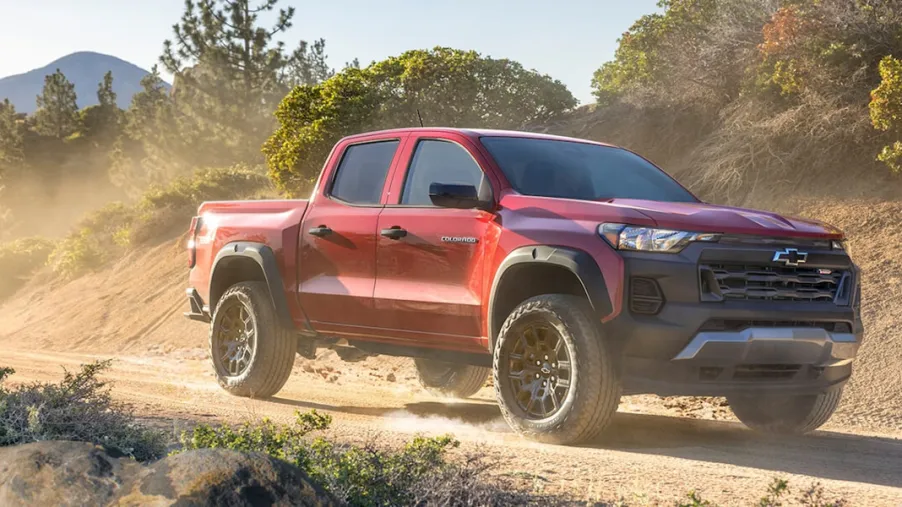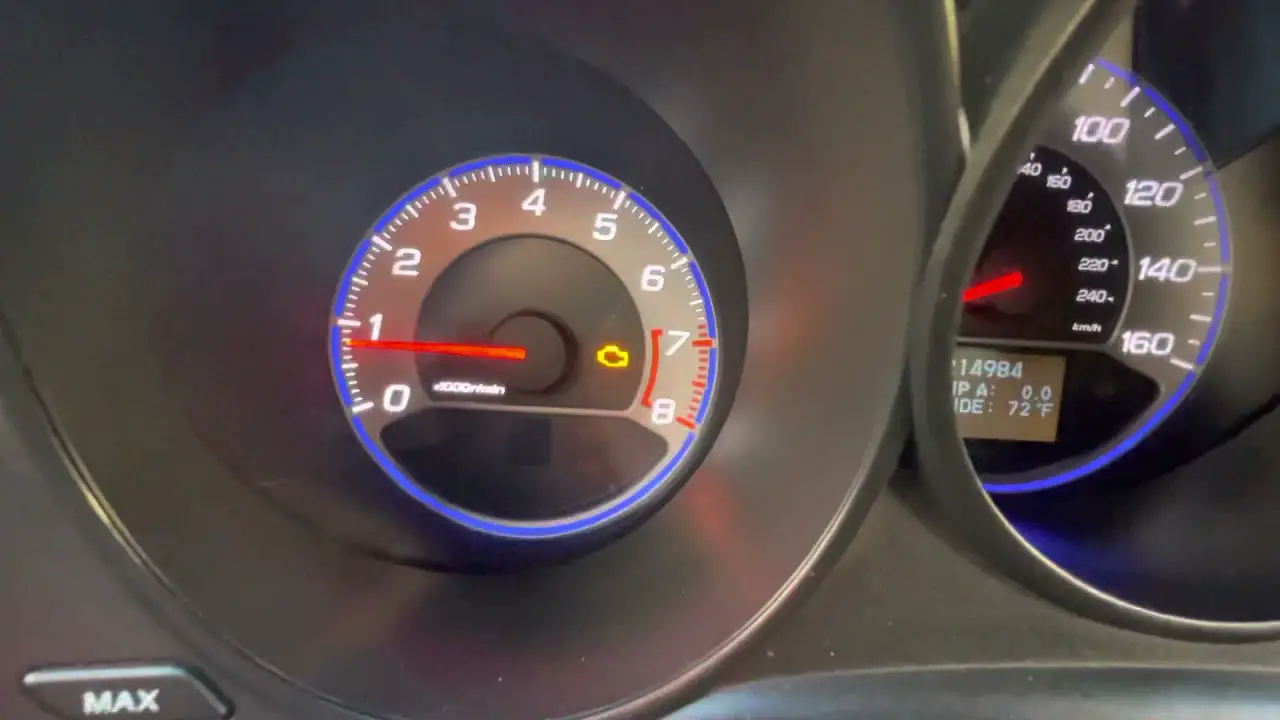If you’ve ever sat in your Toyota Highlander on a snowy day, you might have noticed a button that says “Snow.”
You may be wondering, “What does this button actually do?” Well, it turns out that the Snow Button is like a winter wizard for your car.
In simple terms, when you press it, your Highlander becomes better at handling slippery, snow-covered roads.
Think of it as a helpful friend that gives your car’s tires a little extra grip when things get icy.
The Snow Button adjusts how power is sent to the wheels, making it easier for your Highlander to navigate through snowy or icy conditions.
So, next time the snow starts falling, don’t just stare at that button—give it a press, and let your Toyota Highlander show you its winter magic.
Now, let’s dive into the details of how this button works and why it’s a handy feature for those chilly, snowy days.
What Does the Toyota Highlander Snow Mode Mean?

Several premium Toyota models, including the Sienna, Venza, and Highlander, boast an invaluable Snow Mode feature. This feature not only enhances the vehicle’s drivability but also regulates the interior temperature to ensure passenger comfort in colder conditions.
Engaging Snow Mode proves advantageous when contending with harsh snowy weather, allowing you to navigate challenging conditions and reach your destination without being at the mercy of precise temperatures. This mode optimizes various aspects of the car’s performance, making it well-suited for driving in snowy environments.
This feature becomes particularly beneficial in the face of heavy snowfall while driving. With Snow Mode activated, the vehicle is better prepared to handle both frigid temperatures and slippery road surfaces. Curious about how it operates? Let’s delve into the details:
-
Temperature Regulation for Enhanced Comfort
One of the key advantages of Snow Mode is its ability to increase the interior temperature of the car. Activating the Snow mode button triggers the activation of the heated windshield and front seat heating. To achieve the desired temperature, simply press and hold the Snow mode button until you reach optimal comfort. This feature ensures that both driver and passengers stay warm and cozy during chilly winter drives, contributing to an overall more enjoyable journey.
-
Throttle Management for Controlled Driving
Snow Mode goes beyond temperature control by optimizing throttle application, providing a steadier driving experience. Upon switching to Snow mode, the throttle becomes less responsive to pressure, affording the driver greater control without the risk of slipping. This feature allows for smoother acceleration, enabling you to drive at a more comfortable pace without the need to depress the throttle pedal fully. Additionally, it effectively manages wheel spinning and sideways movement in slippery conditions, ensuring better contact between the tires and the road surface, and consequently, more precise control over the steering wheel.
-
Transmission Optimization for Slippery Conditions
The third noteworthy aspect of Snow Mode lies in its impact on transmission. With Snow Mode activated, the transmission automatically starts from the second gear. This strategic approach minimizes wheel spin when setting off on slippery surfaces, reducing the likelihood of accidental shifts to reverse gear. By enhancing control during acceleration, Snow Mode contributes significantly to the overall stability and safety of winter driving.
-
Enhanced Wheel Control for Improved Traction
Beyond the initial three benefits, Snow Mode takes its effectiveness a step further by regulating power distribution to each wheel. This proactive measure helps balance wheel movement, ensuring that the tires maintain consistent grip on the surface. By reducing the risk of wheel spin, Snow Mode significantly diminishes the chances of the car losing control and spinning. This nuanced control over wheel behavior adds an extra layer of safety, making Snow Mode a comprehensive solution for navigating challenging winter road conditions.
Toyota’s Snow Mode proves to be a multifaceted feature designed to address various aspects of winter driving challenges. From temperature regulation to throttle and transmission optimization, this innovative system provides a holistic solution, making it an essential companion for those venturing into snowy landscapes.
What are the benefits of engaging the Snow Mode in your Toyota Highlander?

Let’s delve into the benefits of incorporating Snow Mode into your vehicle, exploring how this feature proves advantageous in various driving scenarios:
-
Ideal for First-Time Drivers
Snow Mode is especially beneficial for novice drivers who may not be well-versed in handling a vehicle in challenging weather conditions. Whether it’s their first winter behind the wheel or encountering snowy roads, the enhanced capabilities provided by Snow Mode offer a reassuring driving experience.
-
Enhanced Drivability in Mountainous Terrain
If you find yourself navigating mountainous landscapes or roads blanketed in snow, Snow Mode steps in to make your vehicle more manageable. The heightened traction control ensures increased stability, making it easier to maneuver through challenging terrains. This added stability is particularly valuable when driving uphill or downhill in snowy conditions.
-
Improved Traction Control
Snow Mode isn’t just about making your car drivable; it’s about optimizing traction control for improved vehicle operation in tricky conditions. By regulating traction for each wheel, Snow Mode ensures that sufficient power is delivered to maintain better contact with the surface. This increased traction minimizes the risk of slipping, enhancing overall control and safety.
-
Effortless Snow Removal
Getting your car unstuck from snow can be a hassle, but Snow Mode simplifies the process. By intelligently regulating traction for each wheel, the feature provides the necessary power to facilitate easier movement and better contact with the snowy surface. This makes it more convenient for drivers to navigate through or out of snow-covered areas.
-
Improved Handling on Slippery Surfaces
Snow Mode is designed to optimize the handling of your vehicle on slippery surfaces. By adjusting various performance aspects, such as throttle response and transmission settings, it ensures that your car responds effectively to the challenges posed by icy or snowy roads. This comprehensive approach contributes to a smoother and safer driving experience in adverse weather conditions.
-
Confidence for All Drivers
Whether you’re a seasoned driver or a beginner, Snow Mode instills confidence on the road. Its tailored adjustments cater to a range of driving experiences, providing a sense of security for all drivers, regardless of their familiarity with winter driving conditions.
How To Activate Snow Mode On Toyota Highlander? A Step-by-Step Guide
Driving in winter conditions can be challenging, but the Toyota Highlander’s Snow Mode is designed to make it a smoother experience. Activating Snow Mode is a straightforward process, and this step-by-step guide will walk you through each stage, ensuring you’re well-equipped for safer and more controlled winter driving.
Step 1: Familiarize Yourself with the Controls
Before getting started, take a moment to locate the Snow Mode button on your Toyota Highlander. Typically, it’s positioned within easy reach, often on the center console or dashboard. Familiarize yourself with its location to ensure a seamless activation when needed.
Step 2: Start Your Vehicle
Ensure your Toyota Highlander is started and running. Snow Mode is most effective when engaged while the vehicle is in operation, allowing the system to make real-time adjustments to optimize performance in winter conditions.
Step 3: Press the Snow Mode Button
Locate the Snow Mode button and press it. The activation of Snow Mode will trigger a series of adjustments aimed at enhancing traction, stability, and overall control of the vehicle in snowy or slippery conditions. Keep in mind that the Snow Mode indicator may illuminate on your dashboard, indicating that the feature is now active.
Step 4: Adjust Interior Temperature (Optional)
While engaging Snow Mode primarily focuses on optimizing vehicle performance, some Toyota Highlander models may offer additional features. Check if your vehicle allows you to adjust the interior temperature using the same controls. This optional step ensures a comfortable driving experience by activating features like heated seats and windshield.
Step 5: Test Snow Mode Responsiveness
Once Snow Mode is activated, take a moment to test its responsiveness. Gradually apply pressure to the accelerator and observe the controlled acceleration response. Snow Mode is designed to reduce wheel spin and provide a steadier driving experience on snowy or icy surfaces.
Step 6: Deactivating Snow Mode
To return to regular driving mode, simply press the Snow Mode button again. Deactivating Snow Mode will revert your Toyota Highlander to its standard settings, suitable for normal driving conditions.
Additional Tips
It’s advisable to engage Snow Mode before encountering challenging winter conditions to ensure the system is ready when needed.
Familiarize yourself with your vehicle’s user manual for model-specific details and recommendations related to Snow Mode.
Also Read: What Is The Difference: LY6 vs LQ9 – Complete Explanation
When should I use snow mode?

Snow mode is specifically designed for driving on roads and highways, not intended for off-road scenarios. For snowy off-road adventures, it is advisable to utilize the Off-Road All-Terrain drive mode. When navigating wintry conditions on regular roads, activating snow mode proves beneficial, optimizing your vehicle’s traction and stability for safer driving. It’s crucial to choose the appropriate drive mode based on your driving environment to ensure the optimal performance of your vehicle and a secure driving experience.
What is the difference between snow mode and AWD?
The distinction between snow mode and all-wheel drive (AWD) lies in their respective functions and applications in optimizing vehicle performance under specific conditions. Snow mode is a specialized feature found in some vehicles, designed explicitly for enhancing traction and stability in wintry conditions. When activated, it adjusts various vehicle parameters, such as throttle response and transmission settings, to provide better control on snow-covered or slippery roads.
On the other hand, AWD is a broader system that involves distributing power to all four wheels of a vehicle, enhancing traction across different terrains and weather conditions, not limited to snow. AWD is generally engaged at all times, automatically adjusting power distribution based on the driving conditions. While AWD offers versatility in handling various surfaces, including snow, it may not provide the specific optimizations that snow mode does for winter driving.
In essence, snow mode is a targeted feature for optimizing performance in snowy or slippery conditions, while AWD is a comprehensive system aimed at providing improved traction across diverse terrains, making both valuable tools in their respective driving contexts. Understanding the nuances of each system allows drivers to make informed decisions based on the specific challenges they face on the road.
Does snow mode make car faster?
No, snow mode does not make a car faster. In fact, the primary purpose of snow mode is to optimize a vehicle’s performance in slippery or snowy conditions, emphasizing control and stability rather than speed.
When activated, snow mode typically makes adjustments to throttle response, transmission settings, and traction control to prevent wheel spin and enhance grip on slippery surfaces. These modifications are geared towards providing a smoother and more controlled driving experience in winter weather.
While snow mode can contribute to better handling and stability, it does not increase the overall speed of the vehicle. It is essential to recognize that the goal of snow mode is to enhance safety and drivability in adverse weather conditions rather than to boost the vehicle’s speed.
Does snow mode use more fuel?
Yes, engaging snow mode can potentially result in increased fuel consumption. Snow mode is designed to optimize a vehicle’s performance in slippery or snowy conditions by adjusting various parameters, such as throttle response and transmission settings.
These adjustments are made to enhance traction and stability, ensuring better control on snow-covered or icy roads. However, the changes made to achieve these improvements, such as altering throttle sensitivity and gear ratios, may lead to a slightly higher fuel consumption compared to driving in normal conditions.
While the impact on fuel efficiency is generally minimal, it’s essential to be aware that using snow mode may have a modest effect on your vehicle’s fuel economy. If fuel efficiency is a significant concern, drivers may choose to use snow mode judiciously and revert to standard driving modes when not facing challenging weather conditions.
What does the snow button do on a 2013 Toyota Highlander?
The snow button on a 2013 Toyota Highlander activates the vehicle’s Snow Mode, a specialized feature designed to enhance performance in wintry conditions.
When engaged, the Snow Mode adjusts various vehicle parameters to optimize traction, stability, and control on snowy or slippery surfaces. This typically involves modifications to throttle response, transmission settings, and traction control systems.
By pressing the snow button, drivers can experience improved handling and reduced wheel spin, allowing for safer and more controlled driving in adverse weather conditions.
The Snow Mode is particularly useful in scenarios where roads are covered in snow or ice, providing an extra layer of assistance to navigate challenging winter driving conditions with confidence.
FAQs – What Does the Snow Button Do On A Toyota Highlander?
What Does the Snow Button Do on a 2013 Toyota Highlander?
The snow button on a 2013 Toyota Highlander activates the vehicle’s Snow Mode, optimizing traction, stability, and control on snowy or slippery surfaces. This feature involves adjustments to throttle response, transmission settings, and traction control systems, providing improved handling in wintry conditions.
Does Driving in Snow Mode Help?
Yes, driving in Snow Mode can significantly help in snowy or slippery conditions. Snow Mode is specifically designed to enhance a vehicle’s performance by minimizing wheel spin, improving traction, and providing better control, contributing to a safer driving experience in winter weather.
What 4×4 Mode is Best for Snow?
In most cases, the 4×4 mode known as “4H” (4 High) is best for driving in snow. This mode provides power to all four wheels simultaneously, offering improved traction on snowy or icy roads. It’s suitable for varying speeds and conditions commonly encountered during winter driving.
Does Snow Mode Mean All-Wheel Drive (AWD)?
No, Snow Mode does not necessarily mean all-wheel drive (AWD). While both features are designed to enhance traction in adverse conditions, Snow Mode specifically optimizes a vehicle’s performance in snowy or slippery conditions. AWD, on the other hand, is a continuous system distributing power to all four wheels, providing enhanced traction across various terrains.
Is It Best to Turn Off Traction Control in Snow?
It is generally not recommended to turn off traction control in snow. Traction control is a safety feature that prevents wheel spin and helps maintain control in slippery conditions. Keeping traction control on enhances stability and control, contributing to a safer driving experience in snow.
What Is the Best Driving Mode to Save Fuel?
For fuel efficiency, the best driving mode is often “Eco” mode if available. Eco mode optimizes vehicle settings for better fuel economy by adjusting throttle response and other parameters. It encourages smoother acceleration and may contribute to increased fuel efficiency, making it an ideal choice for regular driving conditions when maximum power is not required.
Conclusion – What Does the Snow Button Do On A Toyota Highlander?
The snow button on a 2013 Toyota Highlander activates the Snow Mode, specially designed for safer driving in snowy conditions.
It adjusts how the car responds to acceleration and optimizes traction, making it easier to handle on slippery roads.
Driving in Snow Mode can be beneficial during winter, providing better control and reducing the risk of skidding.
It’s important to note that Snow Mode doesn’t mean the car has all-wheel drive; it’s a feature that works with the existing drivetrain.
Additionally, turning off traction control in the snow is generally not recommended, as it helps maintain stability.
For fuel efficiency, using “Eco” mode in regular driving conditions may help save on fuel.
Understanding these features empowers drivers to make the most of their Toyota Highlander in different driving situations.




